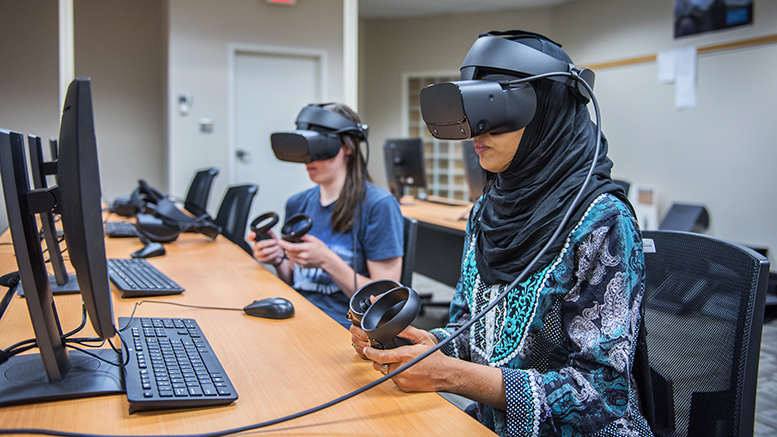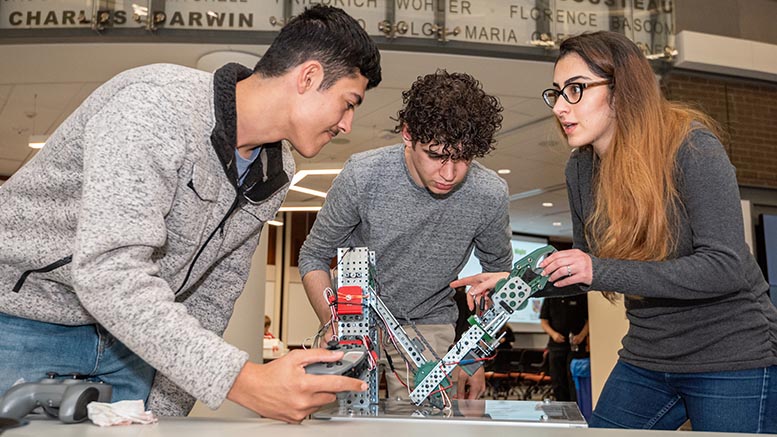As he approached graduation at Atholton High School in Columbia, Maryland, Grant Bunyard didn’t plan to attend Howard Community College (HCC).
He had toured engineering programs at four-year universities in the area and figured he would end up at one of them. But when he looked at Howard’s engineering department, he realized that in addition to lower tuition bills, he would enjoy smaller class sizes and laboratory resources that were as good as those at local universities.
Classes have proved to be very project-oriented, and during Bunyard’s time at HCC, he has had an article published in the school’s Journal of Research in Progress about building and testing wind turbines to help create reusable energy — and presented that research at a nationwide physics conference. He’s also learned to operate everything from research telescopes, to scanning electron microscopes, to 3D printers, and finished twice as a national math competition finalist. All while serving as a track-and-field team captain and winning the decathlon at national championships.
“It’s definitely lived up to what I wanted, and maybe even a little more than I expected,” says Bunyard, who plans to transfer to a four-year school after receiving his associate degree this spring and ultimately pursue a Ph.D. “There’s extracurricular activities, athletic opportunities, research opportunities — there’s pretty much anything you can think of at HCC.”
How it’s done at Howard
For similar reasons, budding engineering students have been matriculating at HCC and other community colleges across the country that offer associate degrees and certificates in engineering. Most of the 400 or so students enrolled in HCC’s program hail from the county and plan to transfer to University of Maryland, says Mark Edelen, chair of engineering and technology at Howard and an associate professor of physics and engineering.
HCC’s department attempts to align with University of Maryland-College Park and University of Maryland-Baltimore County campus curricula, offering tracks within the program for specific disciplines, such as mechanical, electrical and chemical engineering, Edelen says. A small number of students enter the workforce after receiving their associate degrees, typically taking engineering technician positions at Northrop Grumman and other companies that serve the defense industry.
Edelen says his department has the philosophy that engineering is, fundamentally, about doing projects.
“It’s a better way to teach engineering. It motivates the need for the theoretical knowledge and technical skills to be able to solve these problems,” he says. “The types of things most students remember as they look back on engineering are projects, the things they built as a group.”
Effective, small classes
Most classes have between 10 and 20 students, which enables project-based activities, in a way that classes of 50 or 80 students do not.
“Which is why universities don’t do that until later in the curriculum,” Edelen says. “If a student’s taking freshman engineering, it’s going to be 80 or 100 people in that lecture. … Our classroom time can be less traditional lecture time, more interactivity and more project-based learning. Also, at a community college, the faculty are able to focus exclusively on teaching. That’s why we’re here.”
A few projects featured during HCC’s Engineering Projects Night in 2019.
HCC was able to open the new science, engineering, and technology building two years ago, which provided a new lab suite with brand new fabrication equipment of the sort that first wowed Bunyard.
“Our facilities are top-notch, above and beyond what a lot of smaller four-year schools have,” Edelen says. “We’ve been really fortunate here in terms of funding. When students come to visit, they see our lab and they’re just blown away. People in our community are impressed by what students are able to get their hands on, in terms of tools. We think our students are getting good exposure to engineering design and how things are made, which is an important skill. A lot of employers value that.”
What’s happening at Whatcom
The picture is very similar in the engineering program at Whatcom Community College in Bellingham, Washington, where the vast majority of students come from Whatcom County and transfer to either University of Washington, Washington State University or, somewhat less frequently, Western Washington University, says Eric Davishahl, engineering program coordinator and assistant professor.
The student mix is about 50 percent straight out of high school and 50 percent back from the workforce, he says. The most significant change in the student body has been the percentage of international students, which has fallen from about one-third two years ago to less than 10 percent today.
“That has a lot to do with the political climate,” Davishahl says.
International students also are more likely to matriculate out of state, he adds, noting that a couple years ago, University of Minnesota briefly became Whatcom’s most popular articulation destination when a group of seven friends from overseas all matriculated there together.
Mechanical engineering has been probably the most popular program over the past decade, accounting for about 60 percent of students, perhaps slipping to 40 percent to 50 percent as civil engineering has gained interest, Davishahl says.
“I don’t know what that trend is about, if it’s uncertainty about the future, or the perception that the broad mechanical discipline gives you a lot of flexibility,” he says.
Aerospace and aeronautical engineering have always attracted a slice of the population, particularly given the presence of Boeing’s manufacturing facilities in the immediate area, he adds.
Similar draws
Students are drawn to Whatcom rather than starting at area universities for reasons similar to those at Howard County: cost, smaller class sizes and professors whose primary mission is teaching.
“We’re a learner-centered college. My job is to teach,” Davishahl says. “At engineering schools, particularly at the big state universities, teaching is not a top priority for most faculty, especially teaching introductory freshman- and sophomore-level courses.”
Hands-on projects woven throughout the curriculum, and there are greater opportunities for leadership in engineering student clubs with no upperclassmen, he says.
“Students meet the technical prerequisite requirements to transfer at the junior level,” he says. “Within that sequence, they take on undergraduate engineering design projects that are multi-term. They’re just taking a small piece of it on. They have real customers. They’re getting real engineering work, as freshmen. That’s definitely unique to our program.”
Green shoots at Greenville Technical
Engineering technology students at Greenville Technical College in Greenville, South Carolina, are mostly looking to enter the workforce upon graduation. The architectural engineering technology and construction engineering technology programs, which draw about half of their students from Greenville County and the rest from elsewhere in upstate South Carolina, have about 80 and 70 students, respectively, says Catalina Miller, interim department head.
“The majority of our students get their associate degree and go to work,” she says. “We have a small percentage of students who transfer, mostly through an agreement with Clemson University, to finish their four-year degree,” in either architecture or construction sciences management. A smaller number attend University of South Carolina-Upstate to major in engineering management, she adds.
The architectural engineering technology program is about 90 percent hands-on learning, while the construction engineering technology curriculum is somewhat more theoretical, Miller says. The former produces students who go to work as architectural drafters, “or they could be doing specifications for construction contracts, working for suppliers, or serving as assistants to architects,” Miller says.
Construction engineering students “learn how to estimate, do a schedule, and work on real projects. We have a lot of support from local companies,” she says.
Using technology
The majority of students who come straight from high school pay little to no tuition for the program as a result of a state scholarship and other state and/or federal programs, and the engineering programs enjoy 100-percent placement of students before they graduate, Miller says.
“They will see that return, immediately,” she says. “Students enjoy small classroom set-ups. In addition to traditional classes, we also offer online and blended classes to allow flexible schedules for students who have full-time jobs and/or families.”

A student at Greenville Technical College (South Carolina) uses an Oculus Rift. (Photo: GTC)
The program used a federal Perkins grant to purchase Oculus virtual reality technology along with a Google Expeditions kit that enables students to do 3D modeling while working inside their models in a virtual environment, Miller says.
“Students can see and feel the spaces in a more realistic way,” she says. “They can say, ‘This space is too small. This space is too big.’ We can get models from buildings that have already been built, take layers out, take the drywall out, and students can walk inside and see the plumbing and electrical layout.”
Using Google Expeditions, instructors can go to a job site, record a 360-degree video and bring it back to the classroom so students don’t need to travel to a job site every time. This is especially helpful for students with physical disabilities, Miller says.
“We hope we can attract students who think they can’t do it — they like it but don’t think it’s practical,” she says. “We feel like these tools are going to attract that next generation,” she says. “They expect we will have the latest technology.”

